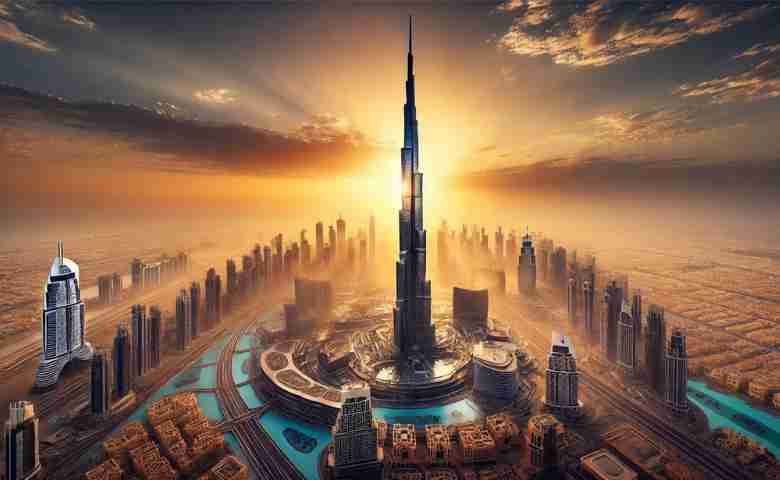Last Updated on July 24, 2024 by Admin
The construction and civil engineering world is filled with numerous awe-inspiring structures, but none are quite as iconic as the Burj Khalifa. Soaring over Dubai, the Burj Khalifa holds the title of the tallest building in the world, standing at an impressive 828 meters (2,722 feet). It has become a symbol of Dubai’s rapid growth and development in the 21st century. But the question on many minds is, which construction company built the Burj Khalifa? Let’s delve into this impressive architectural marvel.
Table of Contents
The Construction of Burj Khalifa: A Brief Overview
Designed by Skidmore, Owings & Merrill LLP, an American architectural firm, Burj Khalifa’s construction was commissioned by Emaar Properties, a United Arab Emirates-based real estate company. The building was initially named Burj Dubai but was renamed Burj Khalifa on its inauguration in honor of the president of the UAE and the ruler of Abu Dhabi, Sheikh Khalifa bin Zayed Al Nahyan.
The colossal structure took approximately six years to complete, with construction beginning in January 2004 and the inauguration ceremony on January 4, 2010. The total construction cost was a staggering 1.5 billion USD.
Samsung C&T: The Company Behind the Tower
The primary construction company that built the Burj Khalifa was Samsung C&T Corporation, South Korean conglomerate Samsung’s construction and trading arm. Samsung C&T was awarded the contract for the building based on its impressive track record, including the construction of the Petronas Towers in Malaysia, which held the title of the world’s tallest building from 1998 to 2004.
Samsung C&T worked in a joint venture with Belgian company BESIX and UAE’s Arabtec. Samsung’s Technology and Construction division was the main stakeholder, with a 55% share in the project, while BESIX held 30% and Arabtec 15%.
Construction Challenges and Innovations
Building the world’s tallest structure was no easy feat and came with its unique challenges. The desert environment posed significant issues with its high temperatures and strong winds. In addition, the immense height of the building required innovative engineering and construction techniques.
Innovative Concrete Pumping
Given Burj Khalifa’s height, one significant challenge faced during construction was pumping concrete to higher floors. Samsung C&T and Putzmeister, a German heavy machinery manufacturer, developed high-pressure resistant pumps capable of transporting concrete up to 600 meters. This allowed the construction team to continuously pour concrete for floors located several hundred meters above the ground.
High-Strength Concrete and Reinforcement
High-performance concrete was used throughout the construction to ensure the building’s stability. High-strength, corrosion-resistant steel reinforcement bars were incorporated into the design to support the towering structure’s immense load.
Wind Engineering and Design Adaptation
Given the tower’s height, wind forces were a significant concern. During the design phase, the building was subjected to numerous wind tunnel tests, which led to several changes to the shape and orientation of the tower to reduce wind forces. This iterative process ensured the tower’s stability without significantly increasing construction costs.
The Result: A Symbol of Architectural Marvel
Upon completion, the Burj Khalifa changed the Dubai skyline and established new benchmarks in engineering and construction. Its iconic design and extraordinary height are a testament to human ingenuity and the remarkable capabilities of Samsung C&T, BESIX, and Arabtec.
Lessons for Construction Industry Professionals
The Burj Khalifa’s construction story is an excellent case study for construction and civil engineering job seekers. Its construction required collaboration among several global companies and professionals from diverse backgrounds. Thus demonstrating the importance of teamwork, cross-cultural communication, and innovative thinking in this industry.
The project’s complexity also underlines the necessity for specialized skills and knowledge. Professionals interested in working on such landmark projects should strive to gain experience in various aspects of construction, including project management, structural design, and material science. Continuous learning and adapting to new technologies and methods are essential to remain relevant in this dynamic industry.
Valuable Resources for Further Readings
Footnotes
Conclusion
The Burj Khalifa is a testament to the prowess of Samsung C&T, BESIX, and Arabtec and the ingenuity of countless engineers, architects, and workers who made this architectural marvel possible. As aspiring construction and civil engineering professionals, one can draw inspiration and valuable lessons from constructing the world’s tallest building.
Related Posts:
- How Technology Will Change The Building Construction Industry
- Upcoming Off-Plan Areas in Dubai for Long-Term Indian Investors
- Structural Engineering: An Extensive Field of Innovation and Ingenuity
- Advanced Materials in Construction: Durability and Design with StruXure Pergolas


